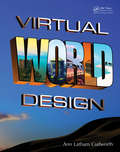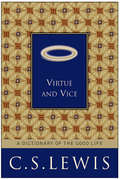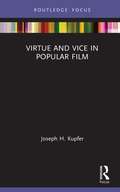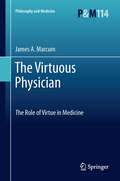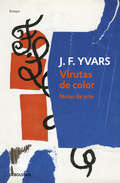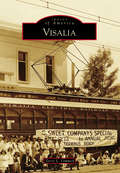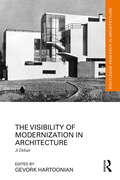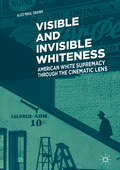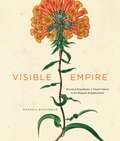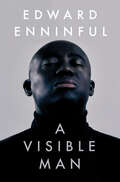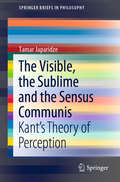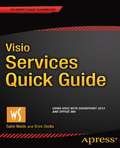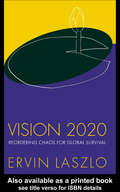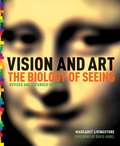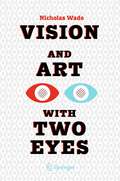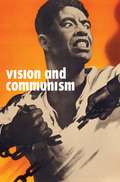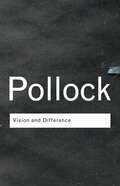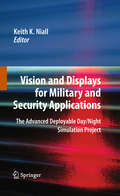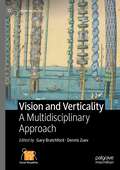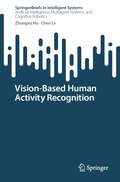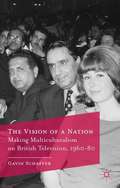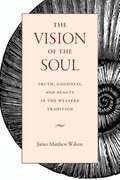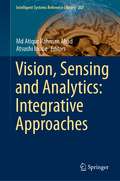- Table View
- List View
Virtual World Design
by Ann CudworthLearn How to Create Immersive Virtual EnvironmentsWritten by an award-winning designer with 20 years of experience designing virtual environments for television and online communities, Virtual World Design explores the intertwining disciplines of 2D graphics, 3D models, lighting, sound, and storytelling. It illustrates how these disciplines come to
Virtue and Vice
by C. S. LewisA Pocket Guide to Goodness Few writers have inspired more readers than author C. S. Lewis -- both through the enchanting volumes of his children's series and through his captivating adult classics such as Mere Christianity, The Screwtape Letters, The Great Divorce, and numerous others. Drawn from many works, this volume collects dictionary-like entries of Lewis's keenest observations and best advice on how to live a truly good life. From ambition to charity, despair to duty, hope to humility, Lewis delivers clear, illuminating definitions to live by.
Virtue and Vice in Popular Film (Routledge Focus on Film Studies)
by Joseph H. KupferThis book addresses a prominent group of virtues and vices as portrayed in popular films to further our understanding of these moral character traits. The discussions emphasize the interplay between the philosophical conception of the virtues and vices and the cinematic representations of character. Joseph H. Kupfer explores how fictional characters possessing certain moral strengths and weaknesses concretize our abstract understanding of them. Because the actions that flow from these traits occur in cinematic contexts mirroring real world conditions, the narrative portrayals of these moral characteristics can further our appreciation of their import. Humility, integrity, and perseverance, for example, are depicted in Chariots of Fire, The Fabulous Baker Boys, and Billy Elliot, while the vices of envy, arrogance and vanity are captured in Amadeus, Whiplash, and Young Adult. This interdisciplinary work in philosophy and film criticism will be of great interest to scholars and students of film studies, philosophy of film, ethics, aesthetics, and popular culture.
The Virtuous Physician
by James A. MarcumAlthough modern medicine enjoys unprecedented success in providing excellent technical care, many patients are dissatisfied with the poor quality of care or the unprofessional manner in which physicians sometimes deliver it. Recently, this patient dissatisfaction has led to quality-of-care and professionalism crises in medicine. In this book, the author proposes a notion of virtuous physician to address these crises. He discusses the nature of the two crises and efforts by the medical profession to resolve them and then he briefly introduces the notion of virtuous physician and outlines its basic features. Further, virtue theory is discussed, along with virtue ethics and virtue epistemology, and specific virtues, especially as they relate to medicine. The author also explores the ontological priority of caring as the metaphysical virtue for grounding the notion of virtuous physician, and two essential ontic virtues--care and competence. In addition to this, he examines the transformation of competence into prudent wisdom and care into personal radical love to forge the compound virtue of prudent love, which is sufficient for defining the virtuous physician. Lastly, two clinical case stories are reconstructed which illustrate the various virtues associated with medical practice, and it is discussed how the notion of virtuous physician addresses the quality-of-care and professionalism crises.
Virutas de color: Notas de arte
by José Francisco YvarsUna selección de artículos y escritos monográficos de J.F. Yvars en los que reflexiona acerca de distintos aspectos del arte del siglo XX, ofreciéndonos una mirada transversal de este mundo: del artista al coleccionista, de la obra a la reflexión crítica. Moviéndose entre tiempos y lugares, viajando a los rincones más recónditos del arte, los ensayos reunidos en Virutas de color trazan un itinerario lleno de contrastes. En los artículos monográficos que conforman la primera parte de este volumen, Yvars reflexiona en torno al cambio de paradigma artístico en los albores del arte abstracto a través de la obra de André Masson y el artista Ràfols-Casamada. Se adentra asimismo en cuestiones que atañen a la teoría estética a través de dos referentes ineludibles de la contemporaneidad: Ernst Gombrich y Cesare Brandi. A su vez, la segunda parte del libro recoge una selección de artículos -algunos de ellos publicados anteriormente enLa Vanguardia y ampliados para esta edición; otros, inéditos- mediante la cual Yvars dialoga con figuras fundamentales de la historia, la crítica del arte y el coleccionismo. Reseñas:«J. F. Yvars ha hecho del arte su camino en la vida.»El País «Yvars lleva más de medio siglo descifrando la experiencia estética en palabras.»Sergi Doria, ABC
Visalia (Images of America)
by Terry L. OmmenWhen the first settlers arrived in what is now Visalia in the fall of 1852, they found a lush river delta in the midst of an oak forest at the base of the Sierra Nevada. The soil was fertile, just right for farming, enabling Visalia to take root as the oldest town in the southern San Joaquin Valley. For the next 163 years, the town provided important products and services, like David Walker's Saddle Shop that became home to the famous Visalia Stock Saddle and Ben Maddox's Mount Whitney Power Company that harnessed water from the Kaweah River for electricity. Now with a population of almost 130,000, the county seat of Tulare County continues to be surrounded by some of the most productive farmland in the world and is a vibrant business center.
The Visibility of Modernization in Architecture: A Debate (Routledge Research in Architecture)
by Gevork HartoonianThis edited collection explores the visibility of modernization in architecture produced in different capitalist regions across the world and provides readers with a historico-theoretical and historico-geographical discussion. Focusing on a particular building type, an influential architect’s work, as well as relevant texts and documents, each chapter addresses the many facets of "delay" which are central to the problematization of capitalism’s progressive dissemination of technological and aesthetic regimes of modernism. This collection underlines the centrality of temporality for a critical understanding of colonialism, modernism, and capitalism. The book is primarily concerned with the historical timeline, the tangential point when a nation enters modernization processes. In exploring modernism in diverse regions such as East Asia, Pacific, Eastern Europe, and Iran, each chapter addresses the historiographic and architectonic unfolding of modernization beyond the western hemisphere. The exploration of these diverse case-studies will be of interest to students of architecture and researchers working on the collision of temporalities and the subject's critical importance for different country’s built-environments.
Visible and Invisible Whiteness: American White Supremacy through the Cinematic Lens
by Alice Mikal CravenVisible and Invisible Whiteness examines the complicity between Classical Hollywood narratives or genres and representations of white supremacy in the cinema. Close readings of D.W. Griffith’s The Birth of a Nation by James Agee and James Baldwin explore these authors’ perspectives on the American mythologies which ground Griffith’s film. The intersectionality of Bordwell’s theories on Classical Hollywood Narrative versus Art Cinema and Richard Dyer’s seminal work on whiteness forms the theoretical base for the book. Featured films are those which have been undervalued or banned due to their hybrid natures with respect to Hollywood and Art Cinema techniques, such as Samuel Fuller’s White Dog and Jean Renoir’s The Southerner. The book offers comparative analyses of American studio-based directors as well as European and European émigrés directors. It appeals to scholars of Film Theory, African American and Whiteness Studies. It provides insight for readers concerned about the re-emergence of white supremacist tensions in contemporary America.
Visible Empire: Botanical Expeditions and Visual Culture in the Hispanic Enlightenment
by Daniela BleichmarBetween 1777 and 1816, botanical expeditions crisscrossed the vast Spanish empire in an ambitious project to survey the flora of much of the Americas, the Caribbean, and the Philippines. While these voyages produced written texts and compiled collections of specimens, they dedicated an overwhelming proportion of their resources and energy to the creation of visual materials. European and American naturalists and artists collaborated to manufacture a staggering total of more than 12,000 botanical illustrations. Yet these images have remained largely overlooked—until now. In this lavishly illustrated volume, Daniela Bleichmar gives this archive its due, finding in these botanical images a window into the worlds of Enlightenment science, visual culture, and empire. Through innovative interdisciplinary scholarship that bridges the histories of science, visual culture, and the Hispanic world, Bleichmar uses these images to trace two related histories: the little-known history of scientific expeditions in the Hispanic Enlightenment and the history of visual evidence in both science and administration in the early modern Spanish empire. As Bleichmar shows, in the Spanish empire visual epistemology operated not only in scientific contexts but also as part of an imperial apparatus that had a long-established tradition of deploying visual evidence for administrative purposes.
A Visible Man: A Memoir
by Edward EnninfulFrom one of our culture's most important changemakers, a memoir of breaking barriers.When Edward Enninful became the first Black editor-in-chief of British Vogue, few in the world of fashion wanted to confront how it failed to represent the world we live in. But Edward, a champion of inclusion throughout his life, rapidly changed that. Now, whether it&’s putting first responders, octogenarians or civil rights activists on the cover of Vogue, or championing designers and photographers of colour, Edward Enninful has cemented his status as one of his world&’s most important changemakers. A Visible Man traces an astonishing journey into one of the world&’s most exclusive industries. Edward candidly shares how as a Black, gay, working-class refugee, he found in fashion not only a home, but the freedom to share with people the world as he saw it. Written with style, grace, and heart, A Visible Man shines a spotlight on the career of one of the greatest creative minds of our times. It is the story of a visionary who changed not only an industry, but how we understand beauty.
The Visible, the Sublime and the Sensus Communis: Kant’s Theory of Perception (SpringerBriefs in Philosophy)
by Tamar JaparidzeThis book argues that Kant develops a theory of perception in the Critique of Judgment from which one can redefine his entire project, viewing and using aesthetics as its backbone, from the transcendental aesthetic of the First Critique to the Critique of Taste in the Third. The author shows us how Kant exonerates the role of faculties that account for such judgments linked by inner senses, inclusive of sensus communis. By re-examining the role of the aesthetic within Kant's critical philosophy, the compelling force of the aesthetic turn is revealed in modern philosophy. The text includes Heidegger’s, Hegel’s and Diderot's complex relationship to Kant in this context.This text provides important scholarship for those interested in the Kantian influence on German Idealism, the aesthetic turn in the continental tradition, especially the Frankfurt school, and more generally, those interested in the encounter between philosophy and art in this historical context.
Visio Services Quick Guide
by Sahil Malik Srini SistlaIn this fast-paced 100-page guide, you'll learn to load, display and interact with dynamic, data-powered Visio diagrams in SharePoint 2013 or Office 365. Visio Services Quick Guide gives you the tools to build anything from a simple project workflow to an organizational infrastructure diagram, powered by real data from SharePoint or SQL Server. Colleagues can load your diagrams entirely in the browser, meaning that a single Visio client installation is enough to get started. Readers with JavaScript experience will also find out how to get additional control over Visio diagrams using the JavaScript mashup API, and how to build a custom data provider. The final chapter covers some useful information on administering Visio Services. Get started bringing your Visio diagrams to life with the Visio Services Quick Guide.
Vision 2020: Reordering Chaos For Global Survival
by Ervin LaszloThis revised edition of the classic text of the period provides both the student and the specialist with an informative account of post-Roman English society.
Vision and Art
by Margaret S. Livingstone David Hubel<p>With the original release of Vision and Art in 2002, Harvard professor Margaret Livingstone successfully bridged the gap between science and art, exploring how great painters fool the brain: why Mona Lisa’s smile seems so mysterious, or Monet’s Poppy Field appears to sway. In the revised and expanded edition, Livingstone presents two new chapters of her latest observations, has substantially expanded other chapters, and updates the rest of the existing text with new insights gleaned from her ongoing research, bringing the book to the cutting edge in the field of neuroscience. <p>Accompanying Livingstone’s lively prose are many charts and diagrams that lucidly illustrate her points, as well as in-depth analyses of the phenomena found in major works of art. Be it the explanation of common optical illusions or the breakdown of techniques painters use to create those illusions, Vision and Art provides a wealth of information for artists, scholars, and scientists alike.</p>
Vision and Art with Two Eyes (Vision, Illusion and Perception #3)
by Nicholas WadeThis book celebrates binocular vision by presenting illustrations that require two eyes to see the effects of cooperation and competition between them. Pictures are flat but by printing them in different colours and viewing them through similarly coloured filters (included with the book) they are brought to life either in stereoscopic depth or in rivalry with one another. They are called anaglyphs and all those in the book display the ways in which the eyes interact. Thus, the reader is an integral element in the book and not all readers will see the same things. The history, science and art of binocular vision can be experienced in ways that are not usually available to us and with images made specifically for this book. The study of vision with two eyes was transformed by the invention of stereoscopes in the early 19th century. Anaglyphs are simple forms of stereoscopes that have three possible outcomes from viewing them – with each eye alone to see the monocular images, with both eyes to see them in stereoscopic depth or rivalry, or without the red/cyan glasses where they can have an appeal independent of the binocularity they encompass. Through the binocular pictures and the words that accompany them there will be an appreciation of just how remarkable the processes are that yield binocular singleness and depth. Moreover, the opportunities for expressing these processes are explored with many examples of truly binocular art.
Vision and Communism
by Tumelo Mosaka Matthew Jesse Jackson Robert Bird Stephanie Smith Christopher P. HeuerIn the last thirty years of the Soviet Communist project, Viktor Koretsky's art struggled to solve an enduring riddle: how to ensure or restore Communism's moral health through the production of a distinctively Communist vision. In this sense Koretsky's art demonstrates what an "avant-garde late Communist art" would have looked like if we had ever seen it mature. Most striking of all, Koretsky was pioneering the visual languages of Benetton and MTV at a time when the iconography of interracial togetherness was still only a vague rumor on Madison Avenue.Vision and Communism presents a series of interconnected essays devoted to Viktor Koretsky's art and the social worlds that it hoped to transform. Produced collectively by its five editors, this writing also considers the visual art, film, and music included in the exhibition Vision and Communism, opening at the Smart Museum of Art in September 2011.
Vision and Design
by Roger FryTwenty-five art-related essays by distinguished British art critic and painter reveal his wide-ranging interests. Writings explore relationships between ancient and modern art and between art and life, examining such diverse topics as the art of the Bushmen, African sculpture, ancient American art, Giotto and the art of Florence, the paintings of Dürer, El Greco and William Blake, the drawings of Aubrey Beardsley, the works of Paul Cézanne, and contemporary domestic architecture. Also includes Fry's most important theoretical statement, his "Essay in Aesthetics." 13 black-and-white illustrations.
Vision and Difference: Feminism, Femininity and Histories of Art (Routledge Classics Ser.)
by Griselda PollockGriselda Pollock provides concrete historical analyses of key moments in the formation of modern culture to reveal the sexual politics at the heart of modernist art. Crucially, she not only explores a feminist re-reading of the works of canonical male Impressionist and Pre-Raphaelite artists including Edgar Degas and Dante Gabriel Rossetti, but also re-inserts into art history their female contemporaries - women artists such as Berthe Morisot and Mary Cassatt. Pollock discusses the work of women artists such as Mary Kelly and Yve Lomax, highlighting the problems of working in a culture where the feminine is still defined as the object of the male gaze. Now published with a new introduction, Vision and Difference is as powerful as ever for all those seeking not only to understand the history of the feminine in art, but also to develop new strategies for representation for the future.
Vision and Displays for Military and Security Applications
by Keith K. NiallThe book discusses advances in projection technologies used for simulation in military and security applications. More specifically, the subject of this book is using high-resolution projection display technology for simulating night vision device conditions while increasing the distance that objects can be simulated under simulated daylight conditions. Topics covered include: advances in high-resolution projection, advances in image generation, advances in geographic modelling or photogrammetric technologies, night vision goggle human factors research, night vision goggle training techniques. The book will have special features including graphs and systems operational architectural diagrams specific to these domains. The main benefit the reader will gain from this book is that it will present leading edge methods for conducting human factors research for night vision device research, while also presenting leading edge technologies used design and apply visual displays for current simulations.
Vision and Verticality: A Multidisciplinary Approach (Social Visualities)
by Gary Bratchford Dennis ZuevThis rich and accessible volume maps current debates within the expanded field of image-based, vertical analysis. With contributions from astronauts, artists, architects, sociologists, urbanists, visual culture theorists, geographers, anthropologists and more the book signals new moves in inter and multidisciplinary research on visual-vertical thinking and related practices within the social sciences, humanities and across the arts. Grounded in socio-visual thinking, Vision and Verticality addresses the emerging shift in the way social scientists move from a sociology of or through images towards a sociology with images. In doing so, this volume illustrates how the sky and atmosphere remain a surprisingly underexplored domain within visual sociology, beyond the framework of drone-related research. Finally, this volume asserts how vertical and atmospherically framed socio-visual analysis is beginning to shape and inform how we see and experience urban spaces, travel, leisure, politics, and environmental challenges through various prisms, including artistic practices, methodological processes, and user-generated content.
Vision-Based Human Activity Recognition (SpringerBriefs in Intelligent Systems)
by Zhongxu Hu Chen LvThis book offers a systematic, comprehensive, and timely review on V-HAR, and it covers the related tasks, cutting-edge technologies, and applications of V-HAR, especially the deep learning-based approaches. The field of Human Activity Recognition (HAR) has become one of the trendiest research topics due to the availability of various sensors, live streaming of data and the advancement in computer vision, machine learning, etc. HAR can be extensively used in many scenarios, for example, medical diagnosis, video surveillance, public governance, also in human–machine interaction applications. In HAR, various human activities such as walking, running, sitting, sleeping, standing, showering, cooking, driving, abnormal activities, etc., are recognized. The data can be collected from wearable sensors or accelerometer or through video frames or images; among all the sensors, vision-based sensors are now the most widely used sensors due to their low-cost, high-quality, and unintrusive characteristics. Therefore, vision-based human activity recognition (V-HAR) is the most important and commonly used category among all HAR technologies.The addressed topics include hand gestures, head pose, body activity, eye gaze, attention modeling, etc. The latest advancements and the commonly used benchmark are given. Furthermore, this book also discusses the future directions and recommendations for the new researchers.
Vision Based Identification and Force Control of Industrial Robots (Studies in Systems, Decision and Control #404)
by Abdullah Aamir Hayat Shraddha Chaudhary Riby Abraham Boby Arun Dayal Udai Sumantra Dutta Roy Subir Kumar Saha Santanu ChaudhuryThis book focuses on end-to-end robotic applications using vision and control algorithms, exposing its readers to design innovative solutions towards sensors-guided robotic bin-picking and assembly in an unstructured environment. The use of sensor fusion is demonstrated through a bin-picking task of texture-less cylindrical objects. The system identification techniques are also discussed for obtaining precise kinematic and dynamic parameters of an industrial robot which facilitates the control schemes to perform pick-and-place tasks autonomously without any interference from the user. The uniqueness of this book lies in a judicious balance between theory and technology within the context of industrial application. Therefore, it will be valuable to researchers working in the area of vision- and force control- based robotics, as well as beginners in this inter-disciplinary area, as it deals with the basics and technologically advanced research strategies.
The Vision of a Nation
by Gavin SchafferTelling the stories behind television's approaches to race relations, multiculturalism and immigration in the 'Golden Age' of British television, the book focuses on the 1960s and 1970s and argues that the makers of television worked tirelessly to shape multiculturalism and undermine racist extremism.
The Vision of the Soul: Truth, Beauty, and Goodness in the Western Tradition
by James Matthew WilsonStory-telling is foundational to the forms of the fine arts, but it is no less foundational to human reason. Human life in turn constitutes a specific kind of form―a story form. The ancient conception of human life as a pilgrimage to beauty itself is one that we can fully embrace only if we see the essential correlation between reason and story and the essential convertibility of truth, goodness and beauty in beauty. By turns a study in fundamental ontology, aesthetics, and political philosophy, Wilson's book invites its readers to a renewal of the West's intellectual tradition.
Vision, Sensing and Analytics: Integrative Approaches (Intelligent Systems Reference Library #207)
by Md Atiqur Rahman Ahad Atsushi InoueThis book serves as the first guideline of the integrative approach, optimal for our new and young generations. Recent technology advancements in computer vision, IoT sensors, and analytics open the door to highly impactful innovations and applications as a result of effective and efficient integration of those. Such integration has brought to scientists and engineers a new approach —the integrative approach. This offers far more rapid development and scalable architecting when comparing to the traditional hardcore developmental approach. Featuring biomedical and healthcare challenges including COVID-19, we present a collection of carefully selective cases with significant added- values as a result of integrations, e.g., sensing with AI, analytics with different data sources, and comprehensive monitoring with many different sensors, while sustaining its readability.
